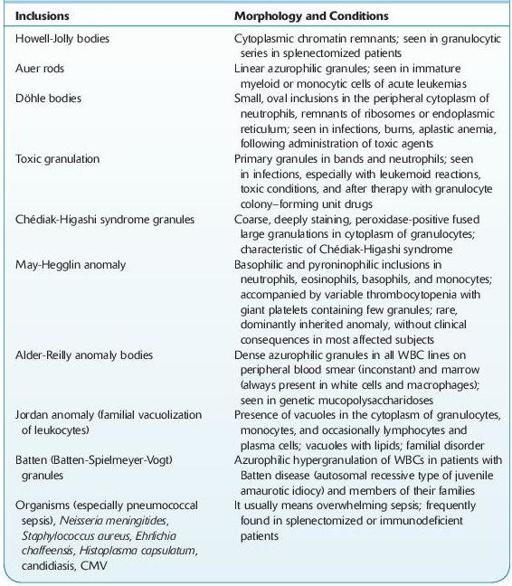Wallach's Interpretation of Diagnostic Tests: Pathways to Arriving at a Clinical Diagnosis (1306 page)
Authors: Mary A. Williamson Mt(ascp) Phd,L. Michael Snyder Md

BOOK: Wallach's Interpretation of Diagnostic Tests: Pathways to Arriving at a Clinical Diagnosis
3.25Mb size Format: txt, pdf, ePub
The WBC morphology may present with unusual inclusions (Table 16.86) or with other abnormalities in granules or morphology (Table 16.87). Some are associated with congenital syndromes; some are acquired. These morphologic abnormalities may or may not be associated with functional abnormalities.
TABLE 16–86. White Blood Cell Inclusions in Peripheral Blood

TABLE 16–87. White Cell Morphologic Abnormalities

WHITE BLOOD CELL COUNTS AND DIFFERENTIALS*
Definition
WBC counts refer to numerical reporting of the total number of WBCs as well as to describing and classifying the white cell components: neutrophils (which include bands), lymphocytes, monocytes, eosinophils, and basophils (Table 16.88).

Normal range
(adults): 4.3–10.3 × 10
3
cells/μL. Different values are reported for infants and children, separated by age groups. Automated counters report results in percentages or as absolute counts of each WBC population. The absolute differential counts are considered more relevant in evaluating WBC abnormalities.
TABLE 16–88. Normal Values for White Blood Cell Counts
*

*
Note that the normal values described in the table do not reflect differences related to age or race.
Use
Most automated WBC counters separate the white cells into five categories. Immature white cells are flagged as abnormal, requiring direct examination of the peripheral blood smears. Recent machines do a six-part differential, the sixth parameter being “immature fraction.”
Abnormalities are discussed separately for each population (see Leukocytosis and Leukopenia and Leukemoid).
Limitations
Poorly prepared stains (mostly the manual ones) may corrupt the ability of the technician to report accurate differentials.
Because in most laboratories the technician examines only 100 randomly selected cells, there is an inherent bias in the report, and rare, but important, abnormal WBCs may be missed, especially in leukopenic conditions. With the recent introduction of automated equipment for reporting differential counts this bias is minimized.
Other books
The Satin Sash by Red Garnier
Darkness Rising (The Endless War Book 2) by D.K. Holmberg
Bitten (Black Mountain Bears Book 2) by Bell, Ophelia, Hunt, Amelie
The Old House on the Corner by Maureen Lee
Haven by Falter, Laury
Do-Gooder by J. Leigh Bailey
The Ka of Gifford Hillary by Dennis Wheatley
The Vampire Club by Scott Nicholson, J.R. Rain
Villainous by Brand, Kristen
Proof of Angels by Mary Curran Hackett